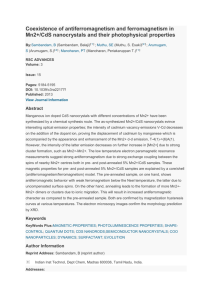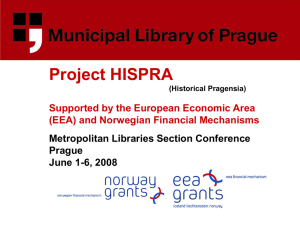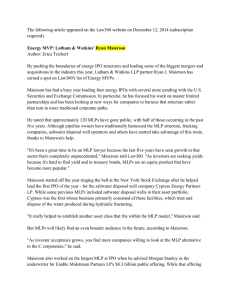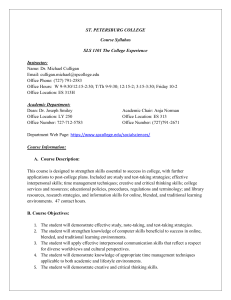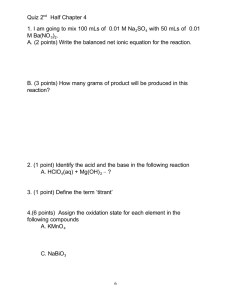Distances between Structural Metal Ion, Substrates, and Allosteric
advertisement
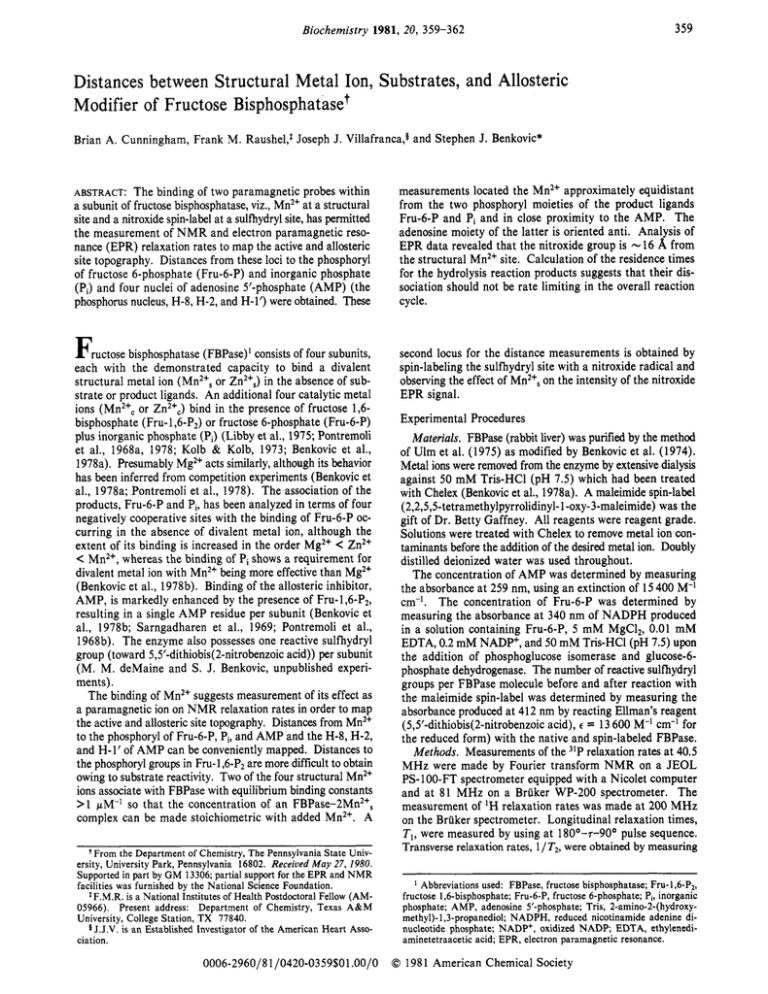
359 Biochemistry 1981, 20, 359-362 Distances between Structural Metal Ion, Substrates, and Allosteric Modifier of Fructose Bisphosphataset Brian A. Cunningham, Frank M. Raushel,* Joseph J. Villafranca,i and Stephen J. Benkovic* ABSTRACT: The binding of two paramagnetic probes within a subunit of fructose bisphosphatase, viz., Mn2+at a structural site and a nitroxide spin-label at a sulfhydryl site, has permitted the measurement of N M R and electron paramagnetic resonance (EPR) relaxation rates to map the active and allosteric site topography. Distances from these loci to the phosphoryl of fructose 6-phosphate (Fru-6-P) and inorganic phosphate (Pi) and four nuclei of adenosine 5'-phosphate (AMP) (the phosphorus nucleus, H-8, H-2, and H-1') were obtained. These measurements located the MnZ+approximately equidistant from the two phosphoryl moieties of the product ligands Fru-6-P and Pi and in close proximity to the AMP. The adenosine moiety of the latter is oriented anti. Analysis of EPR data revealed that the nitroxide group is 16 A from the structural Mn2+site. Calculation of the residence times for the hydrolysis reaction products suggests that their dissociation should not be rate limiting in the overall reaction cycle. F r u c t o s e bisphosphatase (FBPase)' consists of four subunits, each with the demonstrated capacity to bind a divalent structural metal ion (Mn2+, or Zn2+,) in the absence of substrate or product ligands. An additional four catalytic metal ions (Mn2+, or Zn2+,) bind in the presence of fructose 1,6bisphosphate (Fru- 1,6-P2) or fructose 6-phosphate (Fru-6-P) plus inorganic phosphate (Pi) (Libby et al., 1975; Pontremoli et al., 1968a, 1978; Kolb & Kolb, 1973; Benkovic et al., 1978a). Presumably Mg2+acts similarly, although its behavior has been inferred from competition experiments (Benkovic et al., 1978a; Pontremoli et al., 1978). The association of the products, Fru-6-P and Pi, has been analyzed in terms of four negatively cooperative sites with the binding of Fru-6-P occurring in the absence of divalent metal ion, although the extent of its binding is increased in the order Mg2+ C Zn2+ < Mn2+, whereas the binding of Pi shows a requirement for divalent metal ion with Mn2+ being more effective than Mg2+ (Benkovic et al., 1978b). Binding of the allosteric inhibitor, AMP, is markedly enhanced by the presence of Fru-1,6-P2, resulting in a single AMP residue per subunit (Benkovic et al., 1978b; Sarngadharen et al., 1969; Pontremoli et al., 1968b). The enzyme also possesses one reactive sulfhydryl group (toward 5,5'-dithiobis(2-nitrobenzoic acid)) per subunit (M. M. deMaine and S. J. Benkovic, unpublished experiments). The binding of Mn2+suggests measurement of its effect as a paramagnetic ion on NMR relaxation rates in order to map the active and allosteric site topography. Distances from Mn2+ to the phosphoryl of Fru-6-P, Pi, and AMP and the H-8, H-2, and H-1' of AMP can be conveniently mapped. Distances to the phosphoryl groups in Fru- 1,6-P2are more difficult to obtain owing to substrate reactivity. Two of the four structural Mn2+ ions associate with FBPase with equilibrium binding constants >1 pM-' so that the concentration of an FBPase-2Mn2+, complex can be made stoichiometric with added Mn2+. A second locus for the distance measurements is obtained by spin-labeling the sulfhydryl site with a nitroxide radical and observing the effect of Mn2+,on the intensity of the nitroxide EPR signal. t From the Department of Chemistry, The Pennsylvania State University, University Park, Pennsylvania 16802. Received May 27, 1980. Supported in part by GM 13306; partial support for the EPR and NMR facilities was furnished by the National Science Foundation. *F.M.R. is a National Institutes of Health Postdoctoral Fellow (AM05966). Present address: Department of Chemistry, Texas A&M University, College Station, TX 77840. 0 J.J.V. is an Established Investigator of the American Heart Association. - Experimental Procedures Materials. FBPase (rabbit liver) was purified by the method of Ulm et al. (1975) as modified by Benkovic et al. (1974). Metal ions were removed from the enzyme by extensive dialysis against 50 mM Tris-HC1 (pH 7.5) which had been treated with Chelex (Benkovic et al., 1978a). A maleimide spin-label (2,2,5,5-tetramethylpyrrolidinyl1-oxy-3-maleimide) was the gift of Dr. Betty Gaffney. All reagents were reagent grade. Solutions were treated with Chelex to remove metal ion contaminants before the addition of the desired metal ion. Doubly distilled deionized water was used throughout. The concentration of AMP was determined by measuring the absorbance at 259 nm, using an extinction of 15 400 M-' cm-'. The concentration of Fru-6-P was determined by measuring the absorbance at 340 nm of NADPH produced in a solution containing Fru-6-P, 5 mM MgC12, 0.01 mM EDTA, 0.2 mM NADP', and 50 mM Tris-HC1 (pH 7.5) upon the addition of phosphoglucose isomerase and glucose-6phosphate dehydrogenase. The number of reactive sulfhydryl groups per FBPase molecule before and after reaction with the maleimide spin-label was determined by measuring the absorbance produced at 412 nm by reacting Ellman's reagent (5,5'-dithiobis(2-nitrobenzoic acid), t = 13 600 M-' cm-' for the reduced form) with the native and spin-labeled FBPase. Methods. Measurements of the 31Prelaxation rates at 40.5 MHz were made by Fourier transform N M R on a JEOL PS- 100-FTspectrometer equipped with a Nicolet computer and at 81 MHz on a Bruker WP-200 spectrometer. The measurement of 'H relaxation rates was made at 200 MHz on the Bruker spectrometer. Longitudinal relaxation times, T1,were measured by using at 180°-r-900 pulse sequence. Transverse relaxation rates, 1/ T2,were obtained by measuring Abbreviations used: FBPase, fructose bisphosphatase; Fru-1,6-P2, fructose 1,6-bisphosphate; Fru-6-P, fructose 6-phosphate; Pi, inorganic phosphate; AMP, adenosine 5'-phosphate; Tris, 2-amino-2-(hydroxymethyl)- 1,3-propanediol; NADPH, reduced nicotinamide adenine dinucleotide phosphate; NADP', oxidized N A D P EDTA, ethylenediaminetetraacetic acid; EPR, electron paramagnetic resonance. 0006-296018 110420-0359%01.00/0 0 1981 American Chemical Societv 360 B I o c H E M I S T R Y C U N N I N G H A M ET A L . the line width at half-height in hertz, A, and applying the Table I: Paramagnetic Contributions to 31PRelaxation Rates of equation 1 / T 2 = n-A, Pi, Fru-6-P, and AMP at 40.5 MHz and Mn*+-NucleiDistances in FBPase-Mn2+-Ligand Complexes All experiments were performed at 20 f 1 "C. A typical 1.5-mL sample contained 13.5 mM phosphate (Fru-6-P and/or P, or AMP) in 45 mM Tris-HC1 (pH 7.5) containing 10% D 2 0 . The deuterium served as a heteronuclear lock. The AMP samples also contained 0.9 mM Fru-6-P. For most Pi 0.8 3.5 6.3 k 0.5 1.6 2.6 experiments an enzyme solution containing two metal ions Fru-6-P 0.8 (Mn2+or Mg2+) per FBPase tetramer was added to give so3'3 4'0 6.3 i 0.5 1.6 2.6 3.1 lutions 0.8 and l .6 pM in FBPase. A series of experiments AMP 0.8 10.5 5.2 * 0.4 were also performed at 13.5 mM Fru-6-P and Pi at a constant 1.6 9.8 FBPase concentration of 3.32 pM with successive additions a The concentration of each ligand was 13.5 mM. Other details of metal ion to give 1,2, 3, and 4 ratios of metal ion to FBPase. are given in the text. In terms of FBPase concentration. The Those samples were allowed to equilibrate for 1 h after each Mn2+-31Pdistances were calculated from eq 2 by using the average of the l/fl1, values and a T~ of 1.8 X lo-' s. The error limits for addition of metal ion. Since there was no change in the relaxation rate normalized for Mn2+ concentration, 1 /PIP, these distances were calculated by assuming a 25%deviation in both the correlation time and the value for l/fll ,. during the metal ion titration, these studies indicate that contributions to the relaxation rates due to binary Mn2+1970). The distance ( r ) was calculated from eq 3 (Leigh, Fru-6-P or Mn2+-P, complexes were not a contributory factor. 1970) Thus the NMR measurements reflect FBPase-Mn2+-substrate(s) complexes. This was verified by EPR experiments. Longitudinal and transverse relaxation times for the H-8, (3) H-2, and H-I' of AMP were measured at 200 MHz on 1.5-mL where the constants g, p, and h have the usual meanings, and samples containing 13.5 mM AMP, 45 mM Tris-HC1 (pH p and 7, are the magnetic moment and the electron-spin re7 . 3 , 0.9 mM Fru-6-P, and 99% D20. The concentration of laxation time of Mn2+, respectively. The value of C was 2Mn2+,-enzyme was 1.1 or 2.2 pM. obtained from the relative amplitude of the EPR spectrum at FBPase was labeled with the maleimide spin-label by adding saturating Mn2+by using the graph presented by Leigh (1970). enzyme (final concentration of 2 pM) to a solution of the maleimide (10 pg/mL) in 50 mM Tris-HC1 (pH 7.5). The Results solution was incubated at room temperature in the dark for Effect of Mn2+-FBPase on "P Relaxation Rates of Pi, 2 h, after which it was dialyzed extensively against the same AMP, and Fru-6-P. Shown in Table I are the l/fTlp and buffer to remove unreacted maleimide. The FBPase solution 1/jT2p values obtained for the various enzyme-Mn2+,-ligand was then concentrated by using a collodion bag apparatus. complexes. The dissociation constants for Pi, Fru-6-P, and EPR measurements were conducted with a Varian E- 12 AMP for FBPase are all <1 mM, and thus the enzyme is fully spectrometer operating at 9.1 GHz. Samples were placed in saturated with these substrates at the concentrations used in 1-mm quartz cells at 20 rt 1 "C. Spectra of Mn2+ bound to these experiments (Benkovic et al., 1978a,b). Mn2+was added FBPase were obtained in solutions containing 105 pM FBPase to apoenzyme in the proportion of 2 mol of metal ion/enzyme and one Mn2+ per FBPase (40-pL sample volume). Spin-latetramer in order to ensure that there would be no complibeled samples (50 pL) were 34 pM labeled FBPase and (24.80 cations from Mn2+in the bulk solution and to avoid conditions mM in MnC12. where there might be more than one Mn2+ per subunit. Distance Measurements. The distances between the various In an attempt to determine the paramagnetic effect exerted binding sites of rabbit liver FBPase were determined by by the second set of Mn2+ions (Mn2+,) on the 31Prelaxation measuring the effect of enzyme-bound Mn2+on the spin-lattice rates of Pi and Fru-6-P, we titrated the enzyme with Mn2+. relaxation rates (1 / T I ) of the 'H of AMP and 3'P nuclei of In this experiment, 3.3 pM apo-FBPase (13.2 pM subunit Pi, AMP, and Fru-6-P. The paramagnetic contribution (1/ concentration) was titrated with MnCl, to a concentration of TI,) to the measured relaxation rate was calculated according 13.3 pM in four equal increments. The Fru-6-P and Pi conto the equation centrations were 13.5 mM each. Unfortunately titration bel / T l p = I/T1(Mn) - I / T l ( M d (1) yond the 1:l ratio resulted in 31Presonances that were too broad to easily observe. The results are shown in Table 11. where l/T1(Mn) is the spin-lattice relaxation rate in the This experiment also enabled us to detect any change in the presence of Mn2+and l/Tl(Mg) is the relaxation rate in the MII~+-~'P distance when both Fru-6-P and Pi were bound to presence of Mg2+. The Mn2+-nuclei distances were calculated the enzyme at the same time. Within experimental error, the by using a modified form of the Solomon-Bloembergen Mn2+,-31Pdistances to Pi and Fru-6-P seem to be lengthened equation (Solomon & Bloembergen, 1956) slightly when they are simultaneously bound to the enzyme. Effect of Mn2+-FBPase on I f f Relaxation Rates of AMP. The distances from the bound Mn2+of FBPase to the H-8, H-2, and H-I' of AMP were determined by measuring the where f is the mole fraction of enzyme-bound ligand, r, is the effect on Mn2+-FBPase on the spin-lattice relaxation rates correlation time for the dipolar interaction, and wI is the nuof these protons at 200 MHz. The results are shown in Table clear Larmor precession frequency. In this equation C has 111. a value of 8 12 for Mn2+-lH interactions and 601 for Mn2+-3'P Determination of Correlation Times and Distances in interactions. Mn2+-FBPase Complexes. The correlation time for the diThe distance between the nitroxide spin-label and Mn2+s polar effect of Mn2+-FBPase on the nuclei of Pi, Fru-6-P, and was determined by measuring the diminution of the EPR signal AMP was measured in several ways. The first method was of the spin-labeled enzyme upon the addition of Mn2+(Leigh, to measure the peak to peak separation of one of the EPR t:; VOL. 20, NO. 2, 1981 F R U C T O S E BISPHOSPHATASE 361 Table 11: Paramagnetic Contribution to 31PRelaxation Rates of Pi and Fru-6-P as a Function of Mn2+Concentration in the FBPase-Mn7+-Fru-6-PComplex I I1 I11 IV Pi FIU-6-P Pi FIU-6-P Pi FIU-6-P Pi Fru-6-P 3.3 3.3 6.6 6.6 9.9 9.9 13.3 13.3 1.3 1.9 1.6 1.7 1.6 1.7 1.7 1.7 7.3 f 0.6 6.9 f 0.5 7.1 f 0.5 7.0 f 0.5 7.1 f 0.5 7.0 k 0.5 7.0 f 0.5 7.0 f 0.5 The concentrations of Pi and Fru-6-P were 13.5 mM each. In terms of [2MnZ+,-FBPase]. The distances were calculated s. The error by using eq 2 and a correlation time of 1.8 x limits were calculated by using a 25% deviation in both the correlation time and the value for l/fT1,. a Table 111: Paramagnetic Contributions to 'H Relaxation Rates of AMP at 200 MHz by the FBPase-MnZ+Complex [2MnZ+= 1/fl19 enzyme] (X 10- 1/fTzg (X 10- protona (JJM) s-l) S-1) H-8 1.1 2.2 1.1 2.2 1.1 2.2 70 50 2.6 2.9 135 103 H-2 H-I' 1.4 r c (A) f 0.4 4.1 6.8 f 0.5 7.3 f 0.5 2.2 a The concentration of AMP was 13.5 mM. Other details are listed in the text. In terms of FBPase concentration. The distances were calculated by using eq 2 and a correlation time of 1.8 X s. The error limits were calculated by using a 25% deviation in the average value for 1/jTlpand the correlation time. Sincefllp/jTzp for the H-8 proton is a factor of -2, the l/jTlp values may be partially exchange limited, and thus the calculated distance represents a lower limit value. transitions of enzyme-bound Mn2+ (Dwek, 1973). The line width was 30 G. With the assumption that 7c = T2, where T2eis the electron-spin relaxation time for Mn2+-FBPase, 7, was estimated from eq 4 l/Tze = [*(line ~idth)g(3)'/~]/(7.1X G s (4) where g has the value of 2. From this calculation a lower limit s was obtained for 7,. An additional value of 2.2 X assumption was made that T2e= TI, = 7c in order to use eq 2 to calculate Mn2+-nuclei distances (Dwek, 1973). The correlation time was also estimated from the TIp/TZpratio for the H-8 of AMP at 200 MHz. This ratio was 2.0, and a value of 7, = 0.9 X s was obtained from eq 5 (Dwek, 1973). Tip - 4 + 3/(1 + ~ t 7 , ~ ) _ T2p 6/(1 + 01~7:) (5) The T1p/T2p ratio for the 31Pexperiments was large (between 100 and 200), indicating that scalar interactions were possibly contributing to 1/T2, so that this method for calculating 7, for Mn2+-31Pinteractions is unreliable. The l/fT1, values at 81 MHz for the 31Pnuclei of Pi, Fru-6-P, and AMP were not significantly different from the values determined at 40.5 MHz. With the assumption that the correlation time is frequency independent, the 7, for this interaction is 5 1.8 X s, an upper limit value. The Mn2+ to nuclei distances were calculated by using an average of 1.8 X s, giving more weight to the values obtained by EPR and 31PNMR. These distances are listed in Tables 1-111. Mn2+, pM FIGURE 1: Titration of spin-labeled FBPase (32 pM tetramer) with MnZ+. The amplitude of the center line of the EPR spectrum of the spin-labeled FBPase is plotted vs. the concentration of added Mn2+. Mn2+-Nitroxide Distance. The distance from the bound Mn2+ and the one sulfhydryl group of FBPase that can be labeled with a nitroxide spin-label was measured by using the theory of Leigh (1970). The Leigh theory predicts a diminution of the spin-label EPR spectrum upon the addition of a second paramagnetic species, in this case Mn2+. The magnitude of the diminution depends on the distance between the two spins and the correlation time for the interaction. Shown in Figure 1 is a plot of the height of the center line of the nitroxide spectrum vs. the amount of added Mn2+. At saturation the center line is diminished to 56% of its original value. By use of the T2evalue determined from the Mn2+ EPR spectrum (2.2 X s), a Mn*+-nitroxide distance of 16 A was calculated by using eq 3. Nitroxide3IP Distance Estimations. The effect of spinlabeled FBPase on the spin-lattice relaxation rates of the 31P nuclei of Fru-6-P and Pi was measured in order to determine the distance between the spin-labeled site and these ligands. There was, however, no change (<25%) in the T1 values of these nuclei when 20 pM spin-labeled FBPase tetramer and 13.5 mM Fru-6-P and Pi were used. By use of a correlation time of 1 X IO-* s obtained from the nitroxide spectrum, the distance between the nitroxide and the phosphorus atoms of Fru-6-P and Pi is >9.6 A. Discussion The experiments described herein permit the estimation of distances from the structural metal ion binding site to the phosphorus atoms of Fru-6-P, Pi, and AMP on a given subunit of rabbit liver FBPase. The latter Mn2+s to phosphorus measurement with AMP was refined further by obtaining the effect of Mn2+son the H-8, H-2, and H-1' relaxation rates, followed by calculation of their respective distances. In addition, a second locus for mapping allosteric and active site dimensions was sought by spin-labeling the single reactive sulfhydryl group per subunit. The metal ion to phosphorus distances with Pi and Fru-6-P were found to be 6.3 f 0.5 A whereas that to AMP is slightly shorter at 5.2 & 0.4 A. These distances are not consistent with direct coordination of Mn2+sto Pi or the phosphoryl groups. Typically these distances lie in the range of 2.8-3.2 A in inner coordination complexes. The current data should also be compared to the shorter distance of 3.7 f 0.3 A measured previously for the Mn2+,-Fru- 1-P-FBPase complex, this sugar monophosphate being a poor substrate for FBPase (Benkovic et al., 1973). Two interpretations of this difference are that 362 B 1OC HE M IS T R Y C U N N I N G H A M ET A L . Substrate Site I * FIGURE 2: Spatial relationships among the active, allosteric, metal ion, and sulfhydryl sites of FBPase. Distances are in angstroms and are not necessarily drawn to scale. the hydrolytic cleavage of Fru-1,6-P2 to give Pi increases the Mn2+sto phosphorus dimension by -3.0 A, a lengthening generally encountered for the intervention of a water molecule in a directly coordinated Mn2+,-phosphate complex, or simply that Fru-1-P binding differs from that Fru-6-P Pi. Since 4-fold changes in the concentration of added Mn2+ did not affect the calculated values of r in the experiments containing Fru-6-P and Pi in 1:1 ratio with FBPase subunits, we conclude that further population of subunits with Mn2+s(3-4) yields ternary complexes that are similar in their spectrochemical properties and dimensions. Inclusion of the distances between Mn2+sand protons on the adenosine moiety allows construction of the skeletal active site-allosteric site model shown in Figure 2. It is of considerable interest that the Mn2+sion is approximately equidistant from the two phosphoryl moieties of the product ligands, a feature presumably retained in the substrate complex. The close proximity of AMP suggests that Mn2+sfurnishes, albeit indirectly, a binding site for the modifier as well. The adenosine moiety of the latter is oriented anti on the basis of the decrease in Mn2+,-'H distance proceeding from H-8 to H-2. One can crudely estimate the dimension of the FBPase subunit as 22 A by assuming it to be spherical and using a partial specific volume of 0.73 mL/g and subunit molecular weight of 35 750. The reactive sulfhydryl is located within this volume 16 A from the Mn2+sand apparently does not interact with any of the phosphorus nuclei due to the absence of a measurable effect by the nitroxide spin-label on the 31Prelaxation rates. However, orientational constraints acting on the spinlabel may be responsible for the absence of an interaction. + An alternative model for the active siteallosteric site-metal ion site depicted in Figure 2 is one in which one of the sites is on a separate subunit. At present, we cannot unambiguously rule out this possibility, but the data in Table I1 show that progressive occupation of the Mn2+, site of each of the four subunits results in the same Mn2+,-nuclei distances. This result suggests the proximity of all three sites on the same subunit. From the T , , data one can also calculate the minimum dissociation rate constant, l/?min, for Fru-6-P and Pi. These values are 14.7 X lo5 s-' for Pi and 14.0 X lo5 s-' for Fru-6-P (Table I). Since k, for FBPase hydrolysis in the presence of Mn2+is 10 s-', the loss of products should not be limiting in the overall reaction cycle. References Benkovic, S . J., Villafranca, J. J., & Kleinschuster, J. J. (1973) Arch. Biochem. Biophys. 155, 458-463. Benkovic, S . J., Frey, W. A., Libby, C. B., & Villafranca, J. J. (1974) Biochem. Biophys. Res. Commun. 57, 196-203. Benkovic, P. A., Caperelli, C. A., deMaine, M. M., & Benkovic, S . J. (1978a) Proc. Nail. Acad. Sci. U.S.A. 75, 2 18 5-2 189. Benkovic, P. A., Frey, W. A., & Benkovic, S . J. (1978b) Arch. Biochem. Biophys. 191, 7 19-726. Dwek, R. A. (1973) in Nuclear Magnetic Resonance in Biochemistry, p 2 11, Clarendon Press, Oxford, England. Kolb, H. J., & Kolb, H. (1973) Hoppe-Seyler's Z . Physiol. Chem. 354, 31 1-336. Leigh, J. S . (1970) J . Chem. Phys. 52, 2608-2612. Libby, C. B., Frey, W. A., Villafranca, J. J., & Benkovic, S . J. (1975) J. Biol. Chem. 250, 7564-7573. Pontremoli, S., Grazi, E., & Accorsi, A (1968a) Biochemistry 7, 1655-1661. Pontremoli, S., Grazi, E., & Accorsi, A. (1968b) Biochemistry 7, 3628-3633. Pontremoli, S., Melloni, E., Selamino, F., Sparatore, B., & Horecker, B. L. (1978) Arch. Biochem. Biophys. 188, 90-97. Sarngadharan, M. G., Watanabe, A,, & Pogell, B. M. (1969) Biochemistry 8, 1411-1419. Solomon, I., & Bloembergen, N. (1956) J . Chem. Phys. 26, 26 1-275. Ulm, E. J., Pogell, B. M., deMaine, M. M., Libby, C. B., & Benkovic, S . J. (1975) Methods Enzymol. 42, 369-374.



